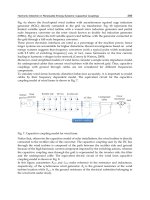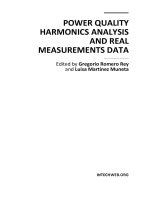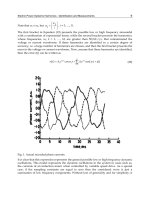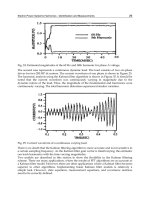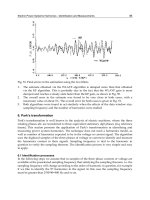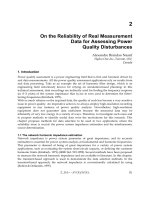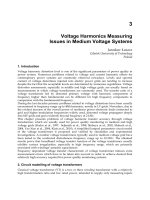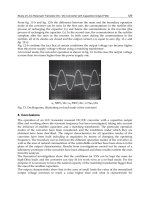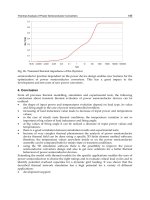Power Quality Harmonics Analysis and Real Measurements Data Part 5 doc
Bạn đang xem bản rút gọn của tài liệu. Xem và tải ngay bản đầy đủ của tài liệu tại đây (1.36 MB, 20 trang )
2
On the Reliability of Real Measurement
Data for Assessing Power
Quality Disturbances
Alexandre Brandao Nassif
Hydro One Inc.,Toronto, ON,
Canada
1. Introduction
Power quality assessment is a power engineering field that is first and foremost driven by
real data measurements. All the power quality assessment applications rely on results from
real data processing. Take as an example the art of harmonic filter design, which is an
engineering field notoriously known for relying on simulation-based planning; in this
technical assessment, data recordings are indirectly used for finding the frequency response
(or R-X plots) of the system impedance that is/are in turn used to determine the filters’
tuning frequencies (Kimbark, 1971).
With so much reliance on the acquired data, the quality of such has become a very sensitive
issue in power quality. An imperative action is to always employ high-resolution recording
equipment in any instance of power quality analysis. Nevertheless, high-resolution
equipment does not guarantee data usefulness because the measured data may be
inherently of very low energy in a variety of ways. Therefore, to investigate such cases and
to propose methods to identify useful data were the motivations for this research. This
chapter proposes methods for data selection to be used in two applications where the
reliability issue is crucial: the power system impedance estimation and the interharmonic
source determination.
1.1 The network harmonic impedance estimation
Network impedance is power system parameter of great importance, and its accurate
estimation is essential for power system analysis at fundamental and harmonic frequencies.
This parameter is deemed of being of great importance for a variety of power system
applications, such as evaluating the system short-circuit capacity, or defining the customer
harmonic limits (Kimbark, 1971)-(IEEE Std. 519-1992). Several methods have been proposed
to measure the network harmonic impedance and are available in literature. In this chapter,
the transient-based approach is used to demonstrate the data selection methods. In the
transient-based approach, the network impedance is conventionally calculated by using
(Robert & Deflandre, 1997)
,
eq
Zh Vh Ih
(1)
Power Quality Harmonics Analysis and Real Measurements Data
70
where ΔV(h) and ΔI(h) are the subtraction in frequency domain of one or more cycles
previous to the transient occurrence from the corresponding cycles containing the transient
disturbance. The objective of this chapter is not to promote the use of the transient-based
approach for determining the network harmonic impedance, nor is it to explain the method
in detail. The reader is encouraged to consult (Robert & Deflandre, 1997) for details. In this
application, the level of accuracy of such estimation can be supported by a set of indices,
which are (but not limited to) the quantization noise in the data acquisition, the frequency
resolution, the energy levels, and the scattering of the results obtained from the data.
1.2 The Interharmonics measurement
Interharmonics are spectral components which frequencies are non-integer multiples of the
supply fundamental frequency. This power quality event represents the target of the second
application of the proposed reliability criteria. Diagnosing interharmonic problems is a
difficult task for a number of reasons: (1) interharmonics do not manifest themselves in
known and/or fixed frequencies, as they vary with the operating conditions of the
interharmonic-producing load; (2) interharmonics can cause flicker in addition to distorting
the waveforms, which makes them more harmful than harmonics; (3) they are hard to
analyze, as they are related to the problem of waveform modulation (IEEE Task Force, 2007).
The most common effects of interharmonics have been well documented in literature (IEEE
Task Force, 2007), (Ghartemani & Iravani, 2005)-(IEEE Interhamonic Task Force, 1997),
(Yacamini, 1996). Much of the published material on interharmonics has identified the
importance of determining the interharmonic source (Nassif et al, 2009, 2010a, 2010b). Only
after the interharmonic source is identified, it is possible to assess the rate of responsibility
and take suitable measures to design mitigation schemes. Interharmonic current spectral
bins, which are typically of very low magnitude, are prone to suffer from their inherently
low energy level. Due to this difficulty, the motivation of the proposed reliability criteria is
to strengthen existing methods for determining the source of interharmonics and flicker
which rely on the active power index (Kim et al, 2005), (Axelberg et al, 2008).
1.3 Objectives and outline
The objective of this research is to present a set of reliability criteria to evaluate recorded
data used to assess power quality disturbances. The targets of the proposed methods are the
data used in the determination of the network harmonic impedance and the identification of
interharmonic sources. This chapter is structured as follows. Section 2 presents the data
reliability criteria to be applied to both challenges. Section 3 presents the harmonic
impedance determination problem and section 4 presents a network determination
case study. Section 5 presents the interharmonic source determination problem and sections
6 and 7 present two case studies. Section 8 presents general conclusions and
recommendations.
2. Data reliability criteria
This section is intended to present the main data reliability criteria proposed to be employed
in the power quality applications addressed in this chapter. The criteria are applied in a
slightly different manner to fit the nature of each problem. As it will be explained in this
chapter, in the context of the network impedance estimation, the concern is ΔI(f) and ΔV(f)
(the variation of the voltage or current), whereas for the case of interharmonic measurement,
On the Reliability of Real Measurement Data for Assessing Power Quality Disturbances
71
the concern is the value of I(f) and V(f). The reason for this will be explained in more detail
in sections 3 and 4, and at this point it is just important to keep in mind that the introduced
criteria is applied in both cases, but with this slight difference.
2.1 The energy level index
As shown in (1), the network impedance determination is heavily reliant on ΔI(f), which is
the denominator of the expression. Any inaccuracy on this parameter can result in great
numerical deviance of the harmonic impedance accurate estimation. Therefore, the ΔI(f)
energy level is of great concern. For this application, a threshold was suggested in (Xu et al,
2002) and is present in (2). If the calculated index is lower than the threshold level, the
results obtained using these values are considered unreliable.
1%.
60
threshold
If
I
IHz
(2)
Fig. 1 shows an example on how this criterion can be used. The energy level for ΔI(f) is
compared with the threshold. For this case, frequencies around the 25
th
harmonic order
(1500Hz) are unreliable according to this criterion.
0
5
10
15
20
25
30
35
40
45
0
20
40
60
0
0.2
0.4
0.6
0.8
1
Number of cases
Harmonic order
Energy Level [%]
Fig. 1. Energy level of ΔI(f) seen in a three-dimensional plot
2.2 Frequency-domain coherence index
This index is used in the problem of the network impedance estimation, which relies on the
transient portion of the recorded voltages and currents (section 3 presents the method in
detail). The random nature of a transient makes it a suitable application for using the power
density spectrum (Morched & Kundur, 1987). The autocorrelation function of a random
process is the appropriate statistical average, and the Fourier transform of the
autocorrelation function provides the transformation from time domain to frequency
domain, resulting in the power density spectrum.
Power Quality Harmonics Analysis and Real Measurements Data
72
This relationship can be understood as a transfer function. The concept of transfer function
using the power spectral method based on correlation functions can be treated as the result
from dividing the cross-power spectrum by the auto-power spectrum. For electrical power
systems, if the output is the voltage and the input is the current, the transfer function is the
impedance response of the system (Morched & Kundur, 1987). The degree of accuracy of the
transfer function estimation can be assessed by the coherence function, which gives a
measure of the power in the system output due to the input. This index is used as a data
selection/rejection criterion and is given by
2
,
VI
VI
VV II
Pf
f
P
f
P
f
(3)
where P
VI
(f) is the cross-power spectrum of the voltage and current, which is obtained by
the Fourier transform of the correlation between the two signals. Similarly, the auto-power
spectrum P
VV
(f) and P
II
(f) are the Fourier transforms of the voltage and current auto-
correlation, respectively. By using the coherence function, it is typically revealed that a great
deal of data falls within the category where input and output do not constitute a cause-effect
relationship, which is the primary requirement of a transfer function.
2.3 Time-domain correlation between interharmonic current and voltage spectra
This index is used for the interharmonic source detection analysis, and is the time-domain
twofold of the coherence index used for the harmonic system impedance. The criterion is
supported by the fact that, if genuine interharmonics do exist, voltage and current spectra
should show a correlation (Li et al, 2001) because an interharmonic injection will result in a
voltage across the system impedance, and therefore both the voltage and current should
show similar trends at that frequency. As many measurement snapshots are taken, the
variation over time of the interharmonic voltage and current trends are observed, and their
correlation is analyzed. In order to quantify this similarity, the correlation coefficient is used
(Harnett, 1982):
111
22
22
11 1 1
,
nnn
IH IH IH IH
iii
nn n n
IH IH IH IH
ii i i
nIiVi Ii Vi
rih
nIi Ii nVi Vi
(4)
where I
IH
and V
IH
are the interharmonic frequency current and the voltage magnitudes of
the n-snapshot interharmonic data, respectively. Frequencies showing the calculated
correlation coefficient lower than an established threshold should not be reliable, as they
may not be genuine interharmonics (Li et al, 2001).
2.4 Statistical data filtering and confidence intervals
In many power quality applications, the measured data are used in calculations to obtain
parameters that are subsequently used in further analyses. For example, in the network
impedance estimation problem, the calculated resistance of the network may vary from
0.0060 to 0.0905 (ohms) in different snapshots (see Fig. 2). The resistance of the associated
network is the average of these results. Most of the calculated resistances are between 0.0654
On the Reliability of Real Measurement Data for Assessing Power Quality Disturbances
73
and 0.0905 (ohms). Those values that are numerically distant from the rest of the data
(shown inside the circles) may spoil the final result as those data are probably gross results.
As per statistics theory, in the case of normally distributed data, 97 percent of the
observations will differ by less than three times the standard deviation [14]. In the study
presented in this chapter, the three standard deviation criterion is utilized to statistically
filter the outlier data.
0 5 10 15 20 25 30
0
0.05
0.1
Snapshots
R
300 Hz
Fig. 2. Calculated 5
th
harmonic resistance over a number of snapshots
In the example presented in Fig. 2, once the resistance of the network is achieved by
averaging the filtered data, the confidence on the obtained results might be questioned.
Instead of estimating the parameter by a single value, an interval likely to include the
parameter is evaluated. Confidence intervals are used to indicate the reliability of such an
estimate (Harnett, 1982). How likely the interval is to contain the parameter is determined
by the confidence level or confidence coefficient. Increasing the desired confidence level will
widen the confidence interval. For example, a 90% confidence interval for the achieved
resistance will result in a 0.0717 ± 0.0055 confidence interval. In the other words, the
resistance of the network is likely to be between 0.662 and 0.772 (ohms) with a probability of
90%.
Fig. 3 shows the calculated harmonic impedance of the network. Error bars are used to show
the confidence intervals of the results. Larger confidence intervals present less reliable
values. In this regard, the estimated resistance at 420 Hz is more reliable than its counterpart
at 300 Hz.
0 200 400 600 800
0
0.02
0.04
0.06
0.08
0.1
Frequency (Hz)
R (Ohm)
Fig. 3. Selected 5
th
harmonic resistance data showing confidence intervals.
Power Quality Harmonics Analysis and Real Measurements Data
74
2.5 Quantization error
Quantization refers to the digitalization step of the data acquisition equipment. This value
dictates the magnitude threshold that a measurement must have to be free of measurement
quantization noise (Oppenheim & Shafer, 1999). The A/D conversion introduces
quantization error. The data collected are in the form of digital values while the actual data
are in analog form. So the data are digitalized with an A/D converter. The error associated
with this conversion is the quantization step. As the energy of current signals drops to a
level comparable to that of quantization noises, the signal may be corrupted, and the data
will, therefore, be unreliable. For this reason, if the harmonic currents are of magnitude
lower than that of the quantization error, they should not be trusted. This criterion was
developed as follows:
1.
The step size of the quantizer is
2,
n
in
V (5)
where n is the number of bits and V
in
is the input range.
2.
The current probe ratio is k
probe
, which is the ratio V/A.
3.
Therefore, the step size in amperes is
.
Iprobe
k
(6)
4.
Finally, the maximum quantization error will be half of the step size.
The input range, number of bits and current probe ratio will depend on the data acquisition
equipment and measurement set up. The measurements presented later in this chapter are
acquired by high-resolution equipment (NI-6020E - 100kbps, 12-bit, 8 channels). For the case
of the system impedance estimation, equation (7) should hold true in order to generate
reliable results for single-phase systems. This criterion is also used for ΔV(f):
() .
error
If I
(7)
For the interharmonic case, the interharmonic current level I(ih) is monitored rather than the
ΔI(f):
() .
error
Iih I
(8)
3. Network harmonic impedance estimation by using measured data
The problem of the network harmonic impedance estimation by using measured data is
explained in this section. Fig. 4 presents a typical scenario where measurements are taken to
estimate the system harmonic impedance. Voltage and current probes are installed at the
interface point between the network and the customer, called the point of common coupling
(PCC). These probes are connected to the national instrument NI-6020E 12-bit data
acquisition system with a 100 kHz sampling rate controlled by a laptop computer. Using
this data-acquisition system, 256 samples per cycle were obtained for each waveform. In Fig.
4, the impedance Z
eq
is the equivalent impedance of the transmission and distribution lines,
and of the step-down and step-up transformers.
On the Reliability of Real Measurement Data for Assessing Power Quality Disturbances
75
Fig. 4. Equivalent circuit for system impedance measurement.
Many methods that deal with measuring the harmonic impedance have been proposed and
published (Xu et al, 2002), (Morched & Kundur, 1987), (Oliveira et al, 1991). They can be
classified as either invasive or non-invasive methods. Invasive methods are intended to
produce a disturbance with energy high enough to change the state of the system to a
different post-disturbance state. Such change in the system is necessary in order to obtain
data records to satisfy (9) and (10), but low enough not to affect the operation of network
equipment. The applied disturbance in the system generally causes an obvious transient in
the voltage and current waveforms. The transient voltage and current data are used to
obtain the impedance at harmonic frequencies. For the case presented in this chapter, the
source of disturbance is a low voltage capacitor bank, but other devices can also be used, as
explained in (Xu et al, 2002), (Morched & Kundur, 1987), (Oliveira et al, 1991)
Therefore, the transient signal is extracted by subtracting one or more intact pre-disturbance
cycles from the cycles containing the transient, as
_
_
,
.
transient disturbance pre disturbance
transient disturbance pre disturbance
VV V V
II I I
(9)
Finally, the network impedance is calculated by using
.
eq
Zh Vh Ih (10)
3.1 Characterization of the capacitor switching transient
Traditionally, transients are characterized by their magnitude and duration. For the
application of network impedance estimation, the harmonic content of a transient is a very
useful piece of information. A transient due to the switching of a capacitor has the following
characteristics (IEEE Std. 1159-1995):
Magnitude: up to 2 times the pre-existing voltage (assuming a previously discharged
capacitor).
Duration: From 0.3ms to 50ms.
Main frequency component: 300Hz to 5 kHz.
The energization of the capacitor bank (isolated switching) typically results in a medium-
frequency oscillatory voltage transient with a primary frequency between 300 and 900 Hz
and magnitude of 1.3-1.5 p.u., and not longer than two 60Hz cycles. Fig. 5 shows typical
transient waveforms and frequency contents due to a capacitor switching. For this case, the
higher frequency components (except the fundamental component) are around 5
th
to 10
th
harmonic (300-600Hz).
Power Quality Harmonics Analysis and Real Measurements Data
76
1000 1200 1400 1600 1800 2000
-200
0
200
400
Voltage [V]
1000 1200 1400 1600 1800 2000
-400
-200
0
200
Time [samples]
Current [A]
0 10 20 30 40 50
0
1
2
3
4
Transient Voltage [V]
0 10 20 30 40 50
0
20
40
Frequency (p.u.)
Transient Current [A]
Fig. 5. Characterization of the transients resulting from a capacitor switching: (a) voltage
and current waveforms during a disturbance, (b) Transient waveforms and frequency
contents.
3.2 Transient Identification
The perfect extraction of the transient is needed for the present application. Several
classification methods were proposed to address this problem, such as neural networks and
wavelet transforms (Anis & Morcos, 2002). Some other methods use criteria detection based
on absolute peak magnitude, the principal frequency and the event duration less than 1
cycle (Sabin et al, 1999).
In this chapter, a simple approach is proposed to perform this task. It calculates the
numerical derivative of the time-domain signals, and assumes that if a transient occurred,
this derivative should be higher than 10. As a result, the numerical algorithm monitors the
recorded waveforms and calculates the derivatives at each data sample; when this
derivative is higher than 10, it can be concluded that a capacitor switching occurred.
4. Impedance measurement case study
More than 120 field tests have been carried out in most of the major utilities in Canada (in
the provinces of British Columbia, Ontario, Alberta, Quebec, Nova Scotia and Manitoba),
and a representative case is presented in this section. Over 70 snapshots (capacitor switching
events) were taken at this site. Using the techniques described in section II, the impedance
results were obtained and are presented in Fig. 6. This figure shows that in the range of
1200-1750Hz there is an unexpected behavior in both components of the impedance. A
resonant condition may be the reason of this sudden change. However, it might be caused
by unreliable data instead. Further investigation is needed in order to provide a conclusion
for this case.
Based on extensive experience acquired by dealing with the collected data, the following
thresholds were proposed for each index:
Energy level: ΔI(f) > 1% and ΔV(f) > 1%.
Coherence: γ(f) ≥ 0.95.
Standard deviation: 0.5
.
Quantization error: ΔI(f) > 0.0244A.
On the Reliability of Real Measurement Data for Assessing Power Quality Disturbances
77
0 500 1000 1500 2000 2500 3000
-0.5
0
0.5
1
1.5
Frequency [Hz]
Impedance [ohms]
Resistance (R)
Reactance (X)
0 500 1000 1500 2000 2500 3000
-0.5
0
0.5
1
1.5
Frequency [Hz]
Impedance [ohms]
Resistance (R)
Reactance (X)
Fig. 6. Harmonic impedance for a sample field test used in the case study.
As the reliability criteria are applied, it is useful to define the following ratio of success:
100%,Ratio Successfull cases Total cases
(11)
where each case is one data snapshot taken at each site.
Fig. 7 shows the success rate of cases for each index in function of frequency. Fig. 7a. also
shows that the application of this index will affect ΔI much more than for ΔV, since the latter
is acquired using voltage probes, which are inherently much more reliable. Since the
impedance measurement is calculated from the ratio -ΔV/ΔI, the voltage threshold is
applied to the denominator and is therefore less sensitive, as shown in (Xu et al, 2002). Fig.
7b. shows that the coherence index does not reveal much information about reliability of the
measurements; however it provides an indicator of the principal frequency of the transient
signals, highlighted in the dotted circle. The standard deviation results presented in Fig. 7c.
show that the impedances measured at frequencies between 1260 and 2000 Hz are very
spread out and are, therefore, unreliable. The same situation occurs for frequencies above
2610 Hz. These results agree with those presented in Fig. 7a. for the threshold used for ΔI.
Fig. 7d. shows that the quantization is not a critical issue and the measurements taken in the
field are accurate enough to overcome quantization noises. However the low quantization
values, especially for current, are of lower values for the unreliable ranges presented in Fig.
7a. and Fig. 7c.
5. Interharmonic source determination
In harmonic analysis, many polluters are usually present in a power distribution system for
each harmonic order because power system harmonics always occur in fixed frequencies,
i.e., integer multiples of the fundamental frequency. All harmonic loads usually generate all
harmonic orders, and therefore, it is common to try to determine the harmonic contribution
of each load rather than the harmonic sources. As opposed to harmonics, interharmonics are
almost always generated by a single polluter. This property of interharmonics can be
explained as follows.
Power Quality Harmonics Analysis and Real Measurements Data
78
0%
20%
40%
60%
80%
100%
120%
60
360
660
960
1260
1560
1860
2160
2460
2760
Frequency (Hz)
Coherence successful rate [%]
0%
20%
40%
60%
80%
100%
120%
60
360
660
960
1260
1560
1860
2160
2460
2760
Frequency Hz
E.L. successful rate [%]
DV
DI
0%
20%
40%
60%
80%
100%
120%
60
360
660
960
1260
1560
1860
2160
2460
2760
Frequency Hz
Q. E. successful rate [%]
Voltage
Current
0%
20%
40%
60%
80%
100%
120%
60
360
660
960
1260
1560
1860
2160
2460
2760
Frequency [Hz]
S. D. successful rate [%]
R
X
0%
20%
40%
60%
80%
100%
120%
60
360
660
960
1260
1560
1860
2160
2460
2760
Frequency (Hz)
Coherence successful rate [%]
0%
20%
40%
60%
80%
100%
120%
60
360
660
960
1260
1560
1860
2160
2460
2760
Frequency Hz
E.L. successful rate [%]
DV
DI
0%
20%
40%
60%
80%
100%
120%
60
360
660
960
1260
1560
1860
2160
2460
2760
Frequency Hz
Q. E. successful rate [%]
Voltage
Current
0%
20%
40%
60%
80%
100%
120%
60
360
660
960
1260
1560
1860
2160
2460
2760
Frequency [Hz]
S. D. successful rate [%]
R
X
Fig. 7. Indices in function of frequency: (a) energy level, (b) coherence, (c) standard
deviation, (d) quantization error.
The main interharmonic sources are adjustable speed drives (ASDs) with a p
1
-pulse rectifier
and a p
2
-pulse inverter and periodically varying loads such as arc furnaces. Their
interharmonic generation characteristics can be expressed as in (12) for ASDs (Yacamini,
1996) and (13) for periodically varying loads (IEEE Task Force, 2007), respectively:
12
1 , 0,1,2 ; 1,2,3 ,
IH z
fpmfpnfm n
(12)
where f and f
z
are the fundamental and drive-operating frequency.
, 1,2,3 ,
IH v
ffnfn
(13)
where f
v
is the load-varying frequency. According to equations (12) and (13), the interharmonic
frequency depends on many factors such as the number of pulses of the converter and
inverter, the drive-operating frequency, or the load-varying frequency. Therefore, the same
frequency of interharmonics is rarely generated by more than one customer.
Based on the above analysis, for interharmonic source determination, the analysis can be
limited to the case of a single source for each of the interharmonic components. The most
popular method currently being used to identify the interharmonic sources is based on the
active power index. Fig. 8 helps to explain the power direction method. For this problem,
the polluter side is usually assumed to be represented by its respective Norton equivalent
circuit. Fig. 8 shows two different scenarios at the metering point between the upstream
(system) and the downstream (customer) sides. Fig. 8a and Fig. 8b show the case where the
interharmonic components come from the upstream side and the downstream side,
respectively. The circuits presented in Fig. 8 are used for each frequency.
On the Reliability of Real Measurement Data for Assessing Power Quality Disturbances
79
Fig. 8. Determination of interharmonic source – two different scenarios.
The interharmonic active power can be obtained from the voltage and current
measurements at a metering point as
*
Re cos ,
IH IH IH IH IH IH
PVIVI
(14)
where |V
IH
| and |I
IH
| are the interharmonic voltage and current magnitudes, respectively,
and φ
IH
is the angle displacement between the interharmonic voltage and current.
The conclusion of the power direction method, therefore, is the following (Kim et al, 2005),
(Axelberg, 2008):
If P
IH
> 0, the interharmonic component comes from the upstream side.
If P
IH
< 0, the interharmonic component comes from the downstream side.
If this criterion is extended to a multi-feeding system like that shown in Fig. 9, the
interharmonic source for each interharmonic can be identified. In such a case, monitoring
equipment should be placed at each feeder suspected of injecting interharmonics into the
system. For the system side measurements (point A), if the measured P
IH
> 0, the
interharmonic component comes from the system. For the customer side measurements
(points B and C), if the measured P
IH
< 0, the interharmonic component comes from the
measured customer.
Fig. 9. System diagram for locating the interharmonic source.
As a given interharmonic frequency has only one source, the power direction method (in
theory) could always reveal the interharmonic source correctly. In reality, as the active
power of the interharmonics is typically very small, the measured data may not be reliable,
so this index may not provide reliable conclusions. On the other hand, the angle φ
IH
can be
very close to either π/2 or –π/2, oscillating around these angles because of measurement
errors, and resulting in the measured active power index swinging its sign and potentially
causing misjudgment. The drifting nature of interharmonics in frequency and the supply
fundamental frequency variation also influence this inaccuracy.
Power Quality Harmonics Analysis and Real Measurements Data
80
6. Interharmonic source determination case study #1
The case study presented in this section illustrates the worst known effect of the
interharmonics at present, which is the interference with control signals at the power line.
The Automatic Meter Reading devices (AMR) of a utility company of the province of
Alberta had experienced difficulties to receive inbound signals in a large oilfield extraction
area. Utility engineers suspected that this interference could be caused by the presence of
interharmonics. Field measurements were carried out at the substation feeder and at large
customers that were suspected to be interharmonic polluters. The arrangement for the field
measurement is shown in Fig. 10. The measured feeder supplies three customers,
codenamed Customer 1, Customer 2 and Customer 3. These customers operate large oil
extracting drives. The measurements were done through potential transformers and current
transformers (PTs and CTs). The data were acquired for a period of two days, taking
automatic snapshots of 5 seconds at every minute. The hardware utilized was a National
Instruments NI-DAQ6020E, which operates at 100kb/s and has 8-channel capability. With
this sampling rate, the recorded waveforms contained 256 points per cycle.
Fig. 10. Field measurement locations at the measured area
After processing all data snapshots taken at the four locations, a spectrum contour plot
measured at the feeder is drawn in order to obtain the frequencies of the interharmonic
components that are present in this system. Fig. 11 shows the contour plot of the data
recorded at the feeder during one of the measured days. From this figure, it can be seen that
there are four dominant interharmonic components, which seem to be two pairs: at around
228 Hz and 348 Hz, and 264 Hz and 384 Hz. These components drift a little in frequency due
to the change of the drive operation conditions, but they exist inside a narrow frequency
range.
On the Reliability of Real Measurement Data for Assessing Power Quality Disturbances
81
Frequency [Hz]
Time [hours]
100 200 300 400 500 600
16:16
17:02
17:50
18:37
19:24
20:11
0.1
0.1
5
0.2
0.2
5
0.3
Fig. 11. Contour plot of the interharmonic data recorded at the feeder
The active power index was monitored at the three loads. This is shown in Fig. 12-Fig. 15.
The system was observed to be fairly balanced, and therefore only the power in phase A is
shown. By looking into these figures, one would conclude that Customer 2 is the source of
interharmonics 228Hz, 348Hz and 384Hz, whereas Customer 3 is the source of
interharmonics 264Hz and 348Hz. As explained in equation (2), it is almost impossible that
an interharmonic component is generated by two sources at the same time. Furthermore,
after deeper investigation, it is shown that this apparent identification of the interharmonic
polluters is incorrect, and the reliability criteria proposed in this chapter is useful in aiding
the researcher to drawing correct conclusions.
228 Hz
-2.5
-2
-1.5
-1
-0.5
0
0.5
1
1 4 7 1013161922252831343740434649525558616467
Time Step
Pa (W)
Customer 3
Customer 2
Customer 1
Fig. 12. Active power at the loads for f
IH
= 228Hz
Power Quality Harmonics Analysis and Real Measurements Data
82
264 Hz
-0.5
-0.4
-0.3
-0.2
-0.1
0
0.1
0.2
0.3
1 4 7 1013161922252831343740434649525558616467
Time Step
Pa (W)
Customer 3
Customer 2
Customer 1
Fig. 13. Active power at the loads for f
IH
= 264Hz
348 Hz
-1.2
-1
-0.8
-0.6
-0.4
-0.2
0
0.2
1 4 7 1013161922252831343740434649525558616467
Time Step
Pa (W)
Customer 3
Customer 2
Customer 1
Fig. 14. Active power at the loads for f
IH
= 348Hz
384 Hz
-10
-8
-6
-4
-2
0
2
4
1 4 7 10 13 16 19 22 25 28 31 34 37 40 43 46 49 52 55 58 61 64 67
Time Step
Pa (W)
Customer 3
Customer 2
Customer 1
Fig. 15. Active power at the loads for f
IH
= 384Hz
On the Reliability of Real Measurement Data for Assessing Power Quality Disturbances
83
6.1 Applying the reliability criteria
The first step to utilize the reliability criteria is to obtain the percentage of snapshots
containing measurements with energy levels above the quantization error. This result for
the case study is shown in Table 1. According to this criterion, the interharmonic currents
measured at the feeder may be unreliable because they are too low as compared to the
current fundamental component. This fact does not mean that the measured interharmonics
are harmless, but simply that 12 bits of the data acquisition device are not enough to
accurately measure their magnitudes. As for the loads, all data are reliable, except those of
Customer 3 at 348 Hz.
IH freq (Hz) Feeder Customer 1 Customer 2 Customer 3
228 0.00 19.44 100.00 91.84
264 0.00 0.00 77.19 81.63
348 0.00 0.00 3.51 0.00
384 0.00 100.00 100.00 100.00
Table 1. Percentage of Snapshots with Energy Level Higher than Quantization Step
The interharmonic voltage-current correlation for all the locations is calculated as well, and
shown in Table 2. The results obtained for the feeder show that its measurements may not
reliable. For the loads, it can be seen that the correlation is generally high, except for that of
Customer 2 at 264 Hz.
IH freq (Hz) Feeder Customer 1 Customer 2 Customer 3
228
0.68 0.98 0.96 0.98
264
0.31 0.96 0.59 0.92
348
0.55 0.96 0.92 0.96
384
0.77 0.99 0.98 0.97
Table 2. V-I Correlation Coefficient (%)
The other reliability criteria are also used but do not add much information to the
conclusions to be drawn in Table 3, which summarizes the reliability at each frequency for
each location.
IH freq (Hz) Feeder Customer 1 Customer 2 Customer 3
228
No Yes Yes Yes
264
No No No Yes
348
No No Yes No
384
No Yes Yes Yes
Table 3. Reliability Summary
Table 4 shows the average of calculated active power at the feeder and at the loads (phase
A). Note that the shaded cells are the ones that should not be trusted.
Power Quality Harmonics Analysis and Real Measurements Data
84
IH Freq
(Hz)
P (W)
Feeder
P (W)
Customer 1
P (W)
Customer 2
P (W)
Customer 3
228
-0.52 0.09 -3.53 0.72
264
-1.14 0.07 0.13 -0.75
348
-1.05 0.08 -1.98 -0.14
384
-6.34 0.58 -23.5 3.64
Table 4. Active Power Results for the Feeder and Customers
6.2 The V
IH
-I
IH
angle displacement
The power direction method relies on the information about the difference between the
interharmonic voltage and current angles. If this difference is close to 90 or 270 degrees, the
cosine of this difference will be very close to zero. For interharmonics of very low
magnitude, the power may oscillate around zero, because the angle displacement usually
exhibit lots of fluctuation due to measurement inaccuracies. Therefore, caution is needed
when using the power direction method, since it is too sensitive to this angle.
In the present case study, such fluctuation happens for interharmonics 264 Hz and 348 Hz.
Furthermore, the active power results shown in Fig. 13 and Fig. 14 reveal that the power
level is very low. This was also shown in Table 1, which revealed that many snapshots
contain data with very low energy level. For these frequencies, the conclusions drawn using
the power direction method cannot be trusted. A final conclusion about these frequencies
will be provided in next subsection by using the theory of interharmonic pairing.
6.3 The Interharmonic phase sequence characteristics
Using the phase sequence characteristics of interharmonics, it can be verified that
interharmonics 228 Hz and 348 Hz of this case study are one pair, and interharmonics 264
Hz and 384 Hz are another pair. From (12), it can be estimated that the drives’ frequencies
are 48 Hz and 54 Hz, and that the number of pulses of the inverter is p
2
= 6. From this
equation, it was also identified that 228 Hz and 264 Hz are negative sequence, whereas 348
Hz and 384 Hz are positive sequence, as explained in (Zhang et al, 2005). Therefore, all
parameters in (12) can be estimated as
228 60 6 48,
364 60 6 54,
348 60 6 48,
384 60 6 54.
(14)
The same conclusion about the sequence is verified through analyzing the measurements:
the symmetrical components of the interharmonic currents are calculated and one of them
(positive-, negative- or zero-sequence) is observed to match the phase currents (the system is
fairly balanced).
Since it is clear that the source of two interharmonic frequencies of a pair is the same, it is
confirmed that Table 4 shows some inconsistencies: Customer 3 cannot be the source of
interharmonic 264 Hz unless it is also the source of interharmonic 384 Hz. It was, however,
determined that Customer 2 is the source of interharmonic 384 Hz. This inconsistency for
Customer 2 undermines the credibility of the conclusions taken at this frequency. It is not
possible that interharmonic 264 Hz comes from both Customer 3 and Customer 2. Finally
On the Reliability of Real Measurement Data for Assessing Power Quality Disturbances
85
the possibility that Customer 3 is the source of the interharmonic 264 Hz can be ruled out
because this frequency is a pair of 384 Hz, which was generated from Customer 2.
7. Interharmonic source determination case study #2
In a second case, interharmonic problems were experienced in another oilfield area of
Alberta, Canada. Measurements were taken at three customers, codenamed Customer 1,
Customer 2, and Customer 3, which were operating big oil extraction ASD drives and were
suspected interharmonic sources. The system diagram is shown in Fig. 16. The
measurements at the metering points revealed that the interharmonic detected frequencies
were present throughout the system.
Fig. 16. Field measurement locations at system #2
Fig. 17 shows a sample contour plot of the spectrum calculated for the three Customers’
currents in order to obtain the frequencies of the interharmonic components present in this
system. Two main interharmonics are identified: 151 Hz and 271 Hz.
Frequency [Hz]
Time [hours]
200 400 600
10:49
10:59
11:09
11:17
11:27
Frequency [Hz]
Time [hours]
200 400 600
16:21
16:31
16:41
16:51
Frequency [Hz]
Time [hours]
200 400 600
12:26
12:36
12:46
1
1.5
2
2.5
3
0.4
0.6
0.8
1
1.2
1.4
1.6
10
15
20
25
(a) (b) (c)
Figure 17. Contour plot of the interharmonic data recorded at the three Customers (phase
A): (a) customer 1, (b) customer 2, (c) customer 3.
7.1 Criteria for determining the reliability of the data
Table 5 shows the percentage of reliable snapshots obtained by using the quantization error
criterion. Only snapshots with an energy level higher than the quantization error could be
Power Quality Harmonics Analysis and Real Measurements Data
86
used. All the data were reliable in this case due to the high magnitude of the interharmonic
components.
IH freq (Hz) Customer 1 Customer 2 Customer 3
151 Hz
100 100 100
271 Hz
100 100 100
Table 5. Reliable Snapshots [%] According to the Quantization Error Criterion for System #2
Table 6 shows the correlation results for the locations, revealing that the interharmonic
voltage and current had a high degree of correlation at the three customer loads.
IH freq (Hz) Customer 1 Customer 2 Customer 3
151 Hz
0.93 0.88 0.98
271 Hz
1.00 1.00 1.00
Table 6. Correlation Results for System #2
7.2 Results
The power direction results are shown in Table 7. In this case, the data was deemed reliable
by all reliability criteria.
Location of measurements IH frequency [Hz]
Sign(P
IH
)
Customer 1
151 +
271 +
Customer 2
151 +
271 +
Customer 3
151 -
271 -
Table 7. Power Direction (at Interharmonic Frequencies) Results for System #2
The information for sign(
P
IH
) reveals that the sign(P
IH
) of Customer 3 is negative, so that
Customer 3 was the source. In this case, the angle displacement between the voltage and
current was not observed to fluctuate at around ±π/2 radians. Therefore, the power
direction method can be used with full confidence.
8. Conclusions
This chapter investigated the reliability of the data used for the power quality disturbances
assessment. The main applications were to estimate the network harmonic impedance and
to determine the interharmonic source. A set of criteria to state about the data reliability was
presented. They consisted in proposing thresholds for the following parameters:
Frequency-domain coherence;
Time-domain correlation;
Quantization error;
Standard deviation;
On the Reliability of Real Measurement Data for Assessing Power Quality Disturbances
87
For the network impedance estimation application, it has been found that the energy level
for
ΔI(f) is a useful data filtering, but for ΔV(f) it has been found that it does not really make
any difference. The Coherence index does not reveal much information about unreliable
measurements but clearly identifies the principal frequency components of the transient.
Analyses carried out on the quantization error level demonstrated that quantization noise is
substantial for high frequencies and that the measurements taken are not significantly
affected by quantization noises. The suggested thresholds for data rejection used were
determined through extensive experience with handling data and provided more accurate
and dependable results. These thresholds can be further adjusted as new data are analyzed
and experience is built to improve the engineering judgment.
For the interharmonic source detection, the power direction method is very sensitive to the
typical low energy level of the interharmonic currents. It was observed that this low energy
level affects the displacement angle between voltage and current, which may prevent using
the method to conclude about some frequencies. Interharmonic pairing theory was used to
draw a final conclusion for the smaller-magnitude interharmonics in the case study. For the
higher magnitude interharmonics, the power direction method could be used with the
confidence provided by the reliability criteria.
9. Acknowledgments
The author gratefully acknowledges the financial support provided by Hydro One to
partially cover the publication of this chapter and also their encouragement into improving
this research work.
The author also expresses his gratitude towards Mr. Edwin Enrique Nino from ATCO
electric for providing the several data sets of the network harmonic impedance collected in
many Canadian utility sites, for processing the data and providing the presented results.
Thanks are also extended to Mr. Hooman Mazin for providing part of the statistical analysis
used in the network harmonic impedance data filtering application.
Finally, the author expresses his appreciation to Prof. Wilsun Xu for his supervision,
technical contributions and high-level advices.
10. References
Anis, W. R. & Morcos, M. M. (2002). Artificial Intelligence and Advanced Mathematical Tools
for Power Quality Applications: A Survey,
IEEE Trans. Power Delivery, vol. 17, no. 2.
Axelberg, P. G. V., Bollen, M. J., Gu, I. Y. (2008). Trace of Flicker Sources by Using the
Quantity of Flicker Power,
IEEE Trans. Power Delivery, vol. 23, no. 1, pp. 465-471.
Ghartemani, M. K. & Iravani, M. R. (2005). Measurement of Harmonics/Interharmonics of
Time-Varying Frequencies,
IEEE Trans. Power Delivery, vol. 20, no. 1, pp. 23-31.
Harnett, D. L. (1982). Statistical Methods, Third Edition, Addison Wesley.
IEEE Std. 519-1992 (1993)
IEEE Recommended Practices and Requirements for Harmonic Control
in Electrical Power Systems
IEEE Std. 1159-1995. (1995).
IEEE Recommended Practice for Monitoring Electric Power Quality.
IEEE Task Force on Harmonics Modeling and Simulation. (2007). Interharmonics: Theory
and Measurement,
IEEE Trans. Power Delivery, vol. 22, no. 4.
IEEE Interharmonic Task Force. (1997).
Cigre 36.05/CIRED 2 CC02 Voltage Quality Working
Group
, Interharmonics in Power Systems.
Power Quality Harmonics Analysis and Real Measurements Data
88
Johnson, R. A. & Wichern, D. W. (2007). Applied Multivariate Statistical Analysis, Sixth
edition, Pearson Prentice Hall.
Kim, T., Powers, E. J., Grady, W. M., Arapostathis, A. (2005). Real and Reactive Power
Analysis for Interharmonics,
Proceedings of the IEEE Electric Ship Technologies
Symposium
, pp. 244-247.
Kimbark, E. (1971).
Direct Current Transmission (vol. 1), John Wiley & Sons
Li, C., Xu, W., Tayjasanant, T. (2001). Interharmonics: Basic Concepts and Techniques for
their Detection and Measurement,
Electric Power Syst. Res., vol. 66, pp. 39-48.
Morched, A. S. and Kundur, P. (1987). Identification and Modeling of Load Characteristics
at High Frequencies,
IEEE Trans. Power Systems, vol. PWRS-2, no. 1, pp. 153-160.
Nassif, A. B, Yong, J., Mazin, H., Wang, X., Xu, W., (2010a). An Impedance-Based Approach
for Identifying Interharmonic Sources.
IEEE Transactions on Power Delivery, vol. 26,
no. 1, pp. 333-340.
Nassif, A. B, Nino, E. E., Mazin, H. (2009). On the Reliability of Real Measurement Data for
Assessing Power Quality Disturbances,
Proceedings of the IEEE PES General Meeting.
Nassif, A. B., Yong, J., Xu, W. (2010b). Interharmonics: Signaling processing issues and
applications,
Proceedings of the IEEE PES General Meeting.
Oppenheim, A. V. and Schafer, R. W. (1999).
Discrete-Time Signal Processing, 2
nd
Ed. (Prentice
Hall: Upper Saddle River, NJ).
Oliveira, A., Oliveira, J. C., Resende J. W., Miskulin M. S. (1991). Practical approaches for AC
system harmonic impedance measurements,
IEEE Trans. Power Delivery, vol. 6, pp.
1721–1726.
Robert, A. & Deflandre, T. (1997). Guide for assessing the network harmonic impedances,
Proceedings of the
Joint CIGRE/CIRED 97, 2-5 June 1997, Conference Publication No. 438.
Sabin, D. D., Grebe, T. E., Brooks, D. L., Sundaram A. (1999), Rules-based Algorithm for
Detecting Transient Overvoltages due to Capacitor Switching and Statistical
Analysis of Capacitor Switching in Distribution Systems,
Proceedings of the IEEE
Transmission and Distribution Conference
, vol. 2, pp. 630-635.
Xu, W., Ahmed, E. E., Zhang, X. and Liu, X. (2002). Measurement of Network Harmonic
Impedances: Practical Implementation Issues and Their Solutions,
IEEE Trans.
Power Delivery
, pp 210-216 vol. 17, no. 1.
Yacamini, R. (1996). Power System Harmonics: Part 4 Interharmonics,
IEE Power Eng. J., pp.
185-193.
Zhang, D., Xu W., Liu, Y. (2005). On the Phase Sequence Characteristics of Interharmonics,
IEEE Trans. Power Delivery, vol. 20, no. 4, pp. 2563-2569.
